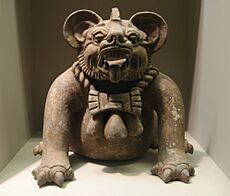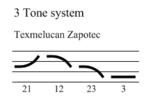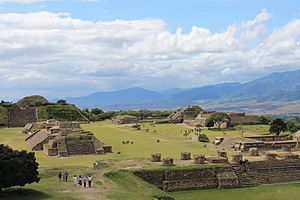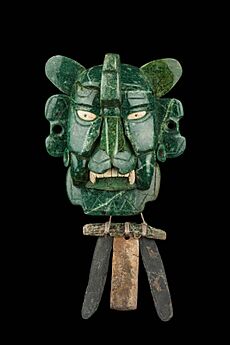Zapotec civilization facts for kids
Quick facts for kids
Zapotec Civilization
Be'ena'a (Zapotec)
|
|||||||
|---|---|---|---|---|---|---|---|
| c. 700 BCE–1521 CE | |||||||

The Zapotec Civilization at its greatest extent
|
|||||||
| Status | Zapotec–Mixtec Alliance | ||||||
| Capital |
|
||||||
| Common languages | Zapotec languages | ||||||
| Religion | Polytheistic | ||||||
| Government | Hereditary monarchy | ||||||
| Monarch | |||||||
|
• 1328–1361
|
Ozomatli | ||||||
|
• 1361–1386
|
Huijatoo | ||||||
|
• 1386–1415
|
Zaachila I | ||||||
| Historical era | Pre-classic – Late post-classic | ||||||
|
• Fall of San José Mogote
|
c. 700 BCE | ||||||
|
• Conflict between Zapotecs and Mixtecs in the empire
|
1519–1521 | ||||||
|
• Spanish Conquest
|
1521 CE | ||||||
|
• Last Zapotec resistance
|
1521–1563 | ||||||
|
|||||||
| Today part of | Mexico • Oaxaca |
||||||
The Zapotec civilization (Be'ena'a (Zapotec), meaning "The People") was an ancient group of people who lived in the Valley of Oaxaca in Mesoamerica. They thrived from around 700 BC until 1521 AD. We know about their culture from archaeological finds that are at least 2,500 years old.
The ancient city of Monte Albán is a famous Zapotec site. It has huge buildings, special ball courts, and amazing tombs. Inside these tombs, archaeologists found beautiful items, including detailed gold jewelry. Monte Albán was one of the first big cities in Mesoamerica. It was the main city of the Zapotec state, which controlled much of the area now known as Oaxaca, Mexico.
Contents
History of the Zapotec People
The Zapotec civilization began in the Y-shaped Central Valleys of Oaxaca around 600 BC. This area had three main valleys, each with its own society. These groups were separated by a large "no-man's-land" in the middle. The modern city of Oaxaca was later built in this central area.
Archaeological evidence, like burned temples and signs of war captives, suggests these three societies often fought. Around 500 BC, the largest settlement, San José Mogote, lost most of its people.
Rise of Monte Albán
During the same time, a new, large settlement grew on a mountain in the "no-man's-land." This city was later named Monte Albán. Pottery found at early Monte Albán looks like pottery from San José Mogote. This suggests that people from San José Mogote moved to the new city.
Later, around 100 BC to 200 AD, walls and forts were built around Monte Albán. This shows the city was likely built to protect against military threats. Archaeologists Joyce Marcus and Kent V. Flannery compared this to how ancient Greek cities formed. Small groups came together in one central city to face outside dangers. This process is called synoikism.
Zapotec Empire Expands
The Zapotec state, based in Monte Albán, started to grow around 400 BC. It continued to expand until about 200 AD. During this time, Zapotec rulers took control of areas outside the Oaxaca Valley. No other nearby groups could match their political or military power.
By 200 AD, the Zapotec had spread their influence far and wide. Monte Albán became the biggest city in the southern Mexican highlands. It kept this important status until about 700 AD.

The Zapotec empire reached its largest size during the Monte Albán 2 period. They conquered or settled new areas far from the Oaxaca Valley. We can see their influence in the pottery styles of these regions. Local pottery styles suddenly changed to match Zapotec designs. This shows that these areas became part of the Zapotec empire.
The Conquest Slab
Archaeologist Alfonso Caso studied Monte Albán in the 1930s. He believed a building on the main plaza showed how much the Zapotec state grew. This building, called Building J, looks like an arrowhead. It's different from other large buildings there.
Building J has over 40 carved stones with hieroglyphic writing. Archaeologists think these carvings show the regions the Zapotec controlled. Each carving also shows a head with a fancy headdress. These likely represent the rulers of those regions. Heads carved upside down might mean the rulers were killed and their lands taken by force. Upright heads might mean those rulers did not fight and were spared. Because of this, archaeologists also call Building J "The Conquest Slab."
Historians Marcus and Flannery explain how Monte Albán expanded. They say that if a main state is much larger than its neighbors, it might just send people to settle new areas. Smaller groups might join peacefully, seeing that fighting would be useless. Larger groups that wanted to stay independent might have been conquered by force. During the Monte Albán 2 period, both peaceful settlement and military conquest happened.
Zapotec Resistance to Conquest
The last major battle between the Aztecs and the Zapotecs happened between 1497 and 1502. This was under the Aztec ruler Ahuizotl. When news arrived that the Aztecs were defeated by the Spanish, the Zapotec King Cosijoeza told his people not to fight the Spanish. He wanted to avoid the same fate for his people.
However, the Zapotecs were still defeated by the Spanish after several battles between 1522 and 1527. Even after this, there were uprisings against the Spanish rulers in 1550, 1560, and 1715.
What Does "Zapotec" Mean?
The name Zapotec was given to them by others. People who spoke the Nahuatl language called them tzapotēcah. This means "inhabitants of the place of sapote" (a type of fruit).
The Zapotec people called themselves Be'ena'a. This means "The Cloud People." This name comes from their belief that their ancestors came from the clouds.
Zapotec Language
| Period | Dates |
|---|---|
| Monte Albán 1 | around 400–100 BC |
| Monte Albán 2 | around 100 BC – 100 AD |
| Monte Albán 3 | around 200–900 AD |
| Monte Albán 4 | around 900–1350 AD |
| Monte Albán 5 | around 1350–1521 AD |
The Zapotec languages are part of a very old language family called Oto-manguean. This family of languages began around 1500 BC.
Today, Zapotec languages are spoken in different parts of Mexico. This includes the Northern Sierra, the Central Valleys, and parts of the Southern Sierra. They are also spoken in the Isthmus of Tehuantepec and along parts of the Pacific Coast. Many Zapotec speakers have moved to Mexico City and Los Angeles, California. There are 7 different Zapotec languages and over 100 dialects.
Zapotec is a tone language. This means the meaning of a word changes depending on the pitch of your voice. For example, saying a word with a high pitch might mean one thing, while saying it with a low pitch means something else. Zapotec languages can have up to 4 different tones: high, low, rising, and falling.
Zapotec Society
Between the Monte Albán 1 and 2 periods, the population in the Valley of Oaxaca grew a lot. As more people lived there, society became more complex. Political power became more centralized, and there were more ceremonial activities.
During Monte Albán 1-2, the valley seemed to be divided into several independent states. Each had its own center of power. By the Monte Albán 3 period, many people moved to Monte Albán itself. This led to a big increase in population and urban growth in the city.
Zapotec Geography
The Central Valleys of Oaxaca are where the Zapotec civilization began. These are three wide valleys—Etla in the west, Ocotlán in the south, and Mitla in the east. They meet at about 4,500 feet above sea level in the center of what is now the state of Oaxaca. This area is about 200 kilometers south of Mexico City.
Mountains surround the valley, including the Sierra Norte to the north. The land is very good for farming and is considered one of the places where maize (corn) first grew.
At the time the Zapotec civilization started, the valley soil was very rich. The oak and pine forests on the mountains had not yet been cut down. There is a dry season from November to May. However, along the rivers, farmers could plant and harvest crops twice a year. The Atoyac River flows through the valley, providing water for a narrow strip of land when it floods.
To water crops away from the river, the Zapotecs used canal irrigation. They used water from small streams to bring water to Monte Albán, which was 400 meters above the valley floor. Archaeologists found parts of a small irrigation system there. It had a dam and a canal. Since this wouldn't be enough for everyone, it's thought there were many other irrigation systems. Crops grown in the valley were not enough for the fast-growing population of Monte Albán. So, crops were also grown on the foothills, where the soil was less fertile and needed artificial irrigation.
New farming methods helped the Zapotec produce enough food. This allowed them to pay tribute to the Spanish conquerors. It also helped them feed themselves even during natural disasters and diseases.
Zapotec Technology and Innovations
The Zapotecs created a calendar system. They also developed a unique writing system that used a separate glyph (picture symbol) for each syllables of their language. This writing system is believed to be one of the first in Mesoamerica. It likely influenced the writing systems of the Maya, Mixtec, and Aztec civilizations. There is some discussion about whether older Olmec symbols (from 650 BC) are a form of writing that came before the Zapotec writing (from 500 BC).
In the Aztec capital of Tenochtitlan, there were Zapotec and Mixtec artists. They made jewelry for the Aztec rulers, called tlatoanis, including Moctezuma II. However, connections with central Mexico go back much further. Archaeologists found a Zapotec neighborhood in Teotihuacan. They also found a Teotihuacan-style "guest house" in Monte Albán.
Other important Zapotec sites from before the Spanish conquest include Lambityeco, Dainzú, Mitla, Yagul, San José Mogote, El Palmillo, and Zaachila.
The Zapotecs were a settled people. They lived in villages and towns in houses made of stone and mortar. They kept records of important historical events using hieroglyphics. In warfare, they used armor made of cotton. The famous ruins of Mitla are believed to have been built by them.
The Zapotecs used different hunting methods. One interesting method was the "deer catapult." This was a young tree bent over and held down by vines. When a deer walked into the trap, it would be caught and flung into the air. The deer would then hit trees or the side of a canyon, killing it.
Zapotec Writing System
At Monte Albán, archaeologists have found long texts written in a glyphic script. Some of these symbols are clearly calendar information. However, the full writing system has not yet been figured out. The script is read in columns from top to bottom. It looks less detailed than the later Classic Maya script. This has led experts to believe it was also less based on sounds than the Maya script.
The oldest known object with Zapotec writing is a stone called a Danzante ("dancer"). It's officially known as Monument 3 and was found in San José Mogote, Oaxaca. It shows a carving of what looks like a dead and bleeding captive. There are two glyphs between his legs, which might be his name. This carving was first dated to 500–600 BC. At first, it was thought to be the earliest writing in Mesoamerica. However, some people now question this date because the monument might have been reused. The Zapotec script seems to have stopped being used in the late Classic period.
Zapotec Religion and Myths

Like most ancient Mesoamerican religions, the Zapotec religion believed in many gods (it was Polytheistic). Some of their known gods included Cocijo, the rain god (similar to the Aztec god Tlaloc); Coquihani, the god of light; and Pitao Cozobi, the god of maize (corn). Zapotec gods were mostly connected to fertility or farming. Both male and female gods are shown in their art, dressed in different ways. Male gods wear loincloths, sometimes with capes. Female gods wear skirts.
There is also some evidence that they worshipped gods not directly from Zapotec culture. These include the Teotihuacan Feathered Serpent, Butterfly God, and rain god. They also worshipped the Nahuatl god of spring, Xipe Totec. It is believed that the Zapotec performed human sacrifice in some of their religious ceremonies.
Origin Stories
There are several legends about how the Zapotec people began. One story says they were the first people in the Oaxaca Valley and were born from rocks. Another says they came from big cats like pumas, jaguars, and ocelots. Another legend says the Zapotec settled in the Oaxaca Valley after founding the Toltec empire. This story says they were descendants of the people from Chicomoztoc. These legends were only written down after the Spanish arrived.
According to Zapotec legends, their ancestors came out of the earth, from caves, or turned into people from trees or jaguars. Their leaders believed they came from special beings who lived among the clouds. They also believed that after they died, they would return to the clouds. The name "Zapotec" comes from this belief. The Zapotecs of the Central Valleys call themselves "Be'ena' Za'a," which means "The Cloud People."
Dedication Rituals
The Zapotec people used special rituals to make their living spaces and buildings sacred. During excavations at Mound III of the Cuilapan Temple Pyramid in Oaxaca, archaeologists found a dedication cache. This cache was a hidden collection of items. It contained many jade beads, two jade earspools, three obsidian blades, shells, stones, a pearl, and small animal bones, likely from birds. These items date back to 700 AD.
Each of these materials had a special religious meaning. Jade was very valuable because it was hard to get and only skilled artists, usually from the elite, could work with it. Obsidian blades are linked to sacrifice, as they were used in bloodletting rituals. Shells and pearls came from the ocean, representing the underworld. The small bird bones represented the sky and its connection to the balanced cosmos (the universe). These artifacts are important because they were placed in a building used for rituals and power. This cache was a dedication ritual, making the Cuilapan Temple Pyramid sacred to these ideas of power, sacrifice, and the link between the underworld and the cosmos.
See also
 In Spanish: Cultura zapoteca para niños
In Spanish: Cultura zapoteca para niños






